
Cross-Platform Gaming: Challenges and Solutions
Want to enjoy gaming with friends across devices but facing challenges? Cross-platform gaming connects players on PCs, consoles, and mobile devices, but it isn’t without hurdles. Here's what you need to know:
- Hardware Differences: Devices vary in power, affecting visuals, frame rates, and load times. Solutions include dynamic resolution scaling, performance modes, and asset streaming.
- Input Methods: Keyboards, controllers, and touchscreens offer different advantages. Developers use input-based matchmaking, aim assists, and UI scaling to balance gameplay.
- Network Issues: Lag, disconnects, and platform-specific problems can disrupt play. Optimized servers, latency compensation, and intelligent matchmaking help ensure smoother connections.
- Syncing Progress: Keeping game saves, updates, and purchases consistent across platforms is solved with centralized cloud systems and unified frameworks.
- Revenue Challenges: Managing payments across stores and regions requires unified payment systems and smart revenue tools.
Cross-platform gaming continues to evolve with cloud technology and unified ecosystems, making it easier to play anywhere, anytime.
Xbox Games Studios Panel: Scaling Cross Platform ...

Hardware Performance Differences
Differences in hardware - from powerful PCs to basic mobile devices - can impact visual quality, frame rates, load times, and overall responsiveness.
How Device Capabilities Affect Gaming
Hardware variations influence several key aspects of gaming performance, including:
- Processing power and graphics capabilities: Determines how well the system handles complex visuals and effects.
- Memory and asset loading: Affects how quickly in-game assets like textures and models are loaded.
- Storage speed: Impacts how fast levels and game data are accessed.
- Display refresh rates and resolutions: Dictates the smoothness and sharpness of visuals.
Strategies to Balance Performance
To address these disparities, developers use several techniques:
- Dynamic resolution scaling: Adjusts the rendering resolution on the fly to keep frame rates steady.
- Asset streaming: Provides high-detail assets for powerful devices and optimized, smaller assets for less capable hardware.
- Performance modes: Offers settings like "High Quality", "Balanced", and "Performance" to let players choose between visual detail and frame rate stability.
These approaches help deliver a consistent gaming experience across a wide range of devices. By fine-tuning performance, developers also support smoother input handling and more stable online play across platforms.
Input and Control Methods
Once hardware performance is optimized, developers must address the challenges posed by different input methods. Each platform's control setup influences gameplay mechanics and competitive fairness.
Impact of Input Methods
Various input methods come with their own strengths and weaknesses:
| Input Method | Pros | Cons |
|---|---|---|
| Keyboard/Mouse | Precise aiming, fast reactions, customizable keys | Limited analog movement, requires a desktop setup |
| Game Controller | Comfortable design, analog stick movement, haptic feedback | Less precise aiming, fewer input options |
| Touchscreen | Direct interaction, intuitive gestures, portable | Lower accuracy, screen visibility issues |
For example, in shooter games, a keyboard and mouse combo often offers better aim and quicker response times compared to controllers or touchscreens.
Balancing Input Differences
To level the playing field across input types, developers implement several techniques:
- Input-Based Matchmaking: Group players based on their control devices to ensure fair competition.
- Adaptive Assists: Features like aim assist, movement smoothing, dynamic sensitivity adjustments, and flexible button mapping help balance gameplay.
- UI Scaling: Adjust control layouts for each platform. This could mean larger touch targets for mobile users, controller-friendly designs on consoles, or customizable shortcuts and HUDs for PC players.
Up next, we’ll dive into network and connection challenges.
sbb-itb-5e834ae
Network and Connection Issues
Once input methods are consistent, the next hurdle is ensuring stable network performance. Even with balanced input across devices, developers face challenges tied to platform-specific traffic patterns and synchronization methods.
Cross-Platform Network Problems
Network performance can vary widely depending on the platform, as each comes with its own architecture and limitations:
| Platform Type | Common Network Issues | Impact on Gameplay |
|---|---|---|
| Console | Bandwidth limits, NAT restrictions | Matchmaking delays, voice chat problems |
| PC | Variable connection quality, firewall issues | Lag spikes, sync errors |
| Mobile | Network switching, weak signals | Higher lag, frequent disconnections |
Network Performance Solutions
To tackle latency and synchronization issues, developers can implement these strategies:
- Optimize packet sizes and update rates: Adjust these based on connection quality. This ensures smooth gameplay on slower networks while leveraging high-speed connections effectively.
- Group players intelligently: Match players by network conditions and skill levels. Use dynamic server allocation and region-based grouping to minimize latency mismatches.
- Adopt a hybrid client-server model: Let the server validate actions while clients predict game states. Techniques like dynamic tick rates and latency compensation can further reduce lag.
Up next, we'll look at how to synchronize user progress and updates across platforms seamlessly.
User Experience Standards
Once latency and synchronization are addressed, the next challenge is ensuring consistent player data and updates across all platforms.
Progress and Update Synchronization
Keeping progress and updates aligned across platforms comes with its own set of challenges:
- Save states: Use a centralized cloud system to store progress and resolve conflicts effectively.
- Version mismatches: Deploy synchronized updates through well-managed pipelines.
- Purchase records: Secure transactions with atomic handling to avoid errors.
- Achievement tracking: Implement a unified framework to track achievements seamlessly.
Cross-Platform Experience Solutions
To deliver a smooth experience across devices, focus on these key strategies:
- Centralized cloud backend: Include conflict resolution and automated recovery mechanisms.
- Responsive UI and input abstraction: Adjust layouts, assets, and controls to suit each device.
- Global CDN: Use delta patches and enable background download queues for efficient updates.
Platform Rules and Revenue
Developers face more than just technical and user experience challenges - they also need to manage multiple payment channels to maximize earnings. Just like keeping game states in sync ensures smooth gameplay, aligning revenue streams requires a similar level of precision.
Here are some common payment challenges developers encounter across platforms:
- Platform store fees and APIs
- Different transaction processes and refund policies
- Regional pricing variations, currency differences, and tax regulations
To tackle these issues and simplify revenue sharing, try these strategies:
Unified Payment Architecture
Create a centralized payment system that streamlines platform APIs and provides a consistent checkout experience. Key elements to include:
- Platform-aware routing to handle transactions seamlessly
- A unified virtual-currency system for in-game purchases
- Synchronized inventory management to track items across platforms
- Rule engines for receipt validation, tax compliance, and regional pricing adjustments
Smart Revenue Management
Adopt flexible tools and rules to handle diverse fee structures and optimize revenue. Consider these approaches:
- Convert real money into a universal in-game currency to simplify transactions
- Use cloud-based entitlements to sync purchases across devices
- Implement dynamic pricing models and tiered commission structures
- Leverage real-time revenue analytics for better decision-making
These systems will continue to evolve, keeping pace with new trends in cross-platform gaming. Up next, we’ll explore the future of cross-platform games and the latest integration developments.
Future of Cross-Platform Games
The gaming industry is moving toward a future where cloud technology and unified ecosystems play a central role. These advancements promise to take performance, input, network, and revenue strategies to the next level.
Cloud gaming and cloud-native systems are breaking free from the limits of local hardware. They allow games to run smoothly across devices like smartphones, consoles, and smart TVs, ensuring consistent performance and easier deployment. This builds on current synchronization and deployment methods, paving the way for more efficient workflows.
One example is doublejack.club's unified account system and $DJCK currency, which showcase how progress synchronization and shared economies can work seamlessly across different games.
Key Technologies Shaping the Future
- Cross-platform frameworks and APIs: Develop once, and your game can run anywhere.
- AI-driven optimization tools: Automatically adjust performance settings for each specific device.
- Unified authentication systems: Make sign-ins simple and hassle-free across platforms.

